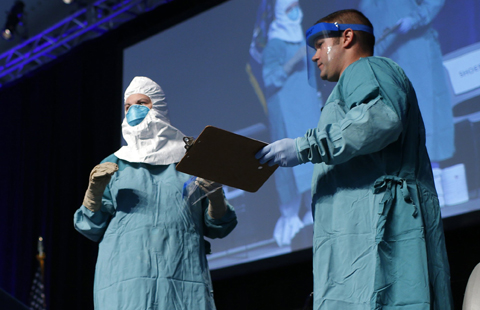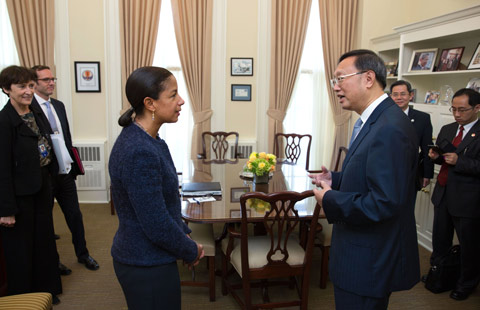Chinese eye California high-speed rails
Updated: 2014-10-22 07:09
By PAUL WELITZKIN in New York(China Daily USA)
|
||||||||
 |
|
A high-speed train travelling to Guangzhou is seen running on Yongdinghe Bridge in Beijing, Dec 26, 2012 file photo. [Photo by Jiao Hongtao/China Daily] |
One of China's top train manufacturers may show on Wednesday that it wants a piece of California's planned $68 billion high-speed railway project.
Wednesday is the deadline for companies or groups to submit an expression of interest for a contract to supply up to 95 trains, and China CNR Corp, its unit Tangshan Railway and US-based SunGroup USA, will be among those submitting an expression of interest, Reuters reported on Tuesday.
By 2029, the rail system will run from San Francisco to Los Angeles, making the trip between the cities in under three hours, and will eventually extend to Sacramento and San Diego, totaling 800 miles with up to 24 stations.
The expressions of interest will be submitted to the California High- Speed Railway Authority in Sacramento. The agency is responsible for designing, building and operating what would be the nation's first high-speed rail system.
"We are not sure if we will publicly identify who made an expression of interest in the trains," Lisa Marie Alley, press secretary for the authority, told China Daily.
Orville Thomas, information officer at the California High-Speed Railway Authority, told China Daily on Tuesday that an expression of interest represents an attempt to gauge a company's interest in providing not only the trains, but also the development of maintenance facilities as well. "It will offer the interested parties an opportunity to comment on the trains," he said.
By the end of this year or early next year, Alley said the authority hopes to solicit Request for Proposals (RFPs) for the trains. That will contain specific technical requirements that the trains must meet and include a request for cost estimates.
The authority's specifications for the trains include requirements that they maintain speeds in excess of 200 miles per hour (mph) and a minimum of 450 seats. On its website, SunGroup touts its high-speed railway for the California project that can reach speeds of up to 300 mph. "It has very good climbing ability, low noise. It is suitable for city and suburb transportation," SunGroup said.
Legislation that green-lighted the California project also included a buy America provision, Thomas said. "The authority is hoping to create a high-speed rail industry in California with this project. This requirement means the trains do not have to be made in California, but they do have to be made in the US."
Alley said it will be during the RFP part of the process that the authority will want to hear from bidders on how they intend to comply with the buy America requirement. She added that the expression of interest is open to all interested parties including State-owned firms. "I don't think we will be looking at that (SOE) in the RFP process," said Thomas.
In Massachusetts, being state owned might be problematic for a CNR-led venture, which is the apparent top bidder on a $566.6 million contract to supply the Massachusetts Bay Transportation Authority with new cars, according to the Boston Globe.
Even though the contract requires that the railcars will be built in the state, the Globe reported that the potential deal has created concern about the company's links to the Chinese government because of allegations of human rights abuses.
Governor Deval Patrick was quoted by the Globe as saying bidders on the contract have been "thoroughly vetted," and that the process has been "transparent and rigorous and competitive." The Massachusetts Department of Transportation board is scheduled to discuss the contract with CNR on Wednesday, according to the Globe.
California voters approved $10 billion in bonds for a high-speed railway in 2008, but they have expressed skepticism as cost estimates have increased. Governor Jerry Brown has vowed to see the train system built. In a 2013 trade mission to Shanghai, Brown courted Chinese investment for the planned high-speed rail line.
In little over a decade China has built the world's largest high-speed rail network and the country is eager to export its technology and know-how overseas. Earlier this month during a visit by Chinese Premier Li Keqiang to Russia, it was announced that Chinese firms and their Russian partners will hold talks on the design, financing, and construction of a 770-kilometer high-speed line connecting Moscow and Kazan.
In Mexico, a Chinese-led consortium was the sole bidder to build a high-speed passenger rail line connecting Mexico City and the city of Queretaro. The eight-company group is led by China Railway Construction Corp Ltd and China South Locomotive and Rolling Stock Co. The Mexican government wants to start construction on the estimated $4 billion project in December and the line is expected to be operational in 2017.
Citing the environmental and economic development benefits, US President Obama has been an enthusiastic backer of high speed rail in the US. The administration's 2009 stimulus bill allotted billions for rail projects. But Republican governors in Florida, Ohio, and Wisconsin rejected the federal funds and outside of California, most high-speed projects have stalled. Most of the funds are being used for upgrades to existing service like Amtrak.
paulwelitzkin@chinadailyusa.com

 Veep and CEO
Veep and CEO
 US Healthcare workers attend Ebola educational session
US Healthcare workers attend Ebola educational session
 Kate makes first public appearance after pregnancy
Kate makes first public appearance after pregnancy
 Chinese may go after California high-speed rail project
Chinese may go after California high-speed rail project
 Terracotta warriors attract celebrities around the world
Terracotta warriors attract celebrities around the world
 US-China solar pact holds big potential: Analyst
US-China solar pact holds big potential: Analyst
 Top 10 richest women in China
Top 10 richest women in China
 Yang Jiechi meets with US National Security Advisor
Yang Jiechi meets with US National Security Advisor
Most Viewed
Editor's Picks

|

|

|

|

|

|
Today's Top News
General aviation poised to grow in China
Chinese train maker wins Massachusetts contract
Ottawa police say male suspect in attack and soldier are dead
Johnson & Johnson Plans Ebola Vaccine Testing
China's space launch to pave the way for lunar probe
Shooting locks down Canada's parliament
Book tells story of 'comfort women'
US-China solar pact holds big potential: analyst
US Weekly

|

|







